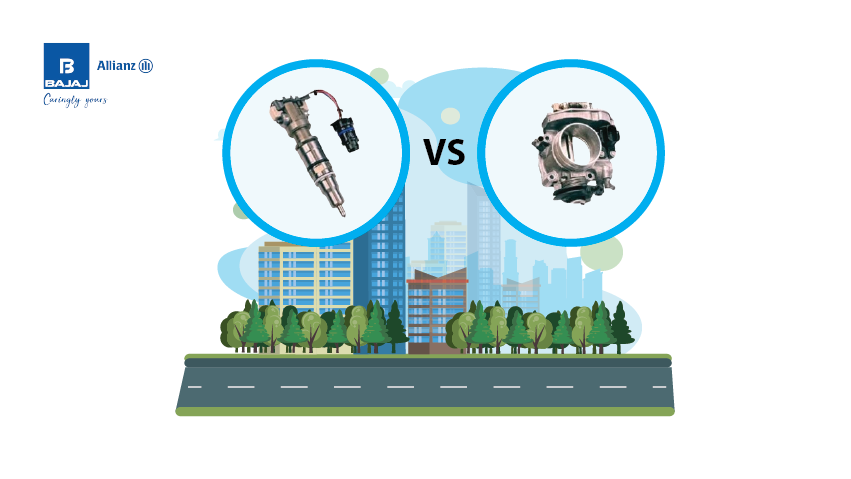In the world of two-wheelers, the debate between fuel injection and carburettor systems has sparked discussions among riders, mechanics, and enthusiasts alike. Each system has its merits and drawbacks, and the choice between the two can significantly impact a bike's performance, fuel efficiency, and overall riding experience. Let’s explore the intricacies of the fuel injection and carburettor debate and shed light on the pros and cons of each.
The Carburettor Legacy
Carburettors have been a staple in the two-wheeler industry for decades. These mechanical devices mix air and fuel in precise proportions before delivering the mixture to the engine. Carburettors are known for their simplicity and cost-effectiveness. They have been integral in the development of many iconic bikes, fostering a sense of nostalgia among riders.
Pros of Carburettors
The following are the pros of a carburettor:
1. Simplicity
Carburettors are mechanically straightforward, making them easy to understand and maintain.
2. Cost
Carburettors are generally less expensive to manufacture and repair than fuel injection systems. If the carburettor of your two-wheeler were to get damaged, the low repair costs involved would make it easier for you to pay for a replacement out of pocket, instead of filing a
motor insurance claim.*
3. Tinkering
Some riders enjoy the ability to tweak carburettors for personalized performance adjustments.
Cons of Carburettors
The cons of a carburettor are as follows:
1. Fuel Efficiency
Bikes with carburettors may not be as fuel-efficient as their fuel-injected counterparts, especially in varying riding conditions.
2. Cold Starts
Cold starts can be a challenge with carburettors, requiring a choke mechanism to enrich the fuel mixture.
The Rise of Fuel Injection
Fuel injection systems, on the other hand, represent a more modern approach to delivering fuel to the engine. These systems use engine control unit (ECU), which is a type of electronic circuit, and injectors to precisely control the amount of fuel entering the combustion chamber. The result is improved fuel efficiency, better throttle response, and reduced emissions.
Pros of Fuel Injection
The pros of fuel injection are as follows:
1. Precision
Fuel injection systems provide precise control over the air-fuel mixture, optimizing combustion for better performance.
2. Fuel Efficiency
Fuel-injected bikes tend to be more fuel-efficient, adapting to various riding conditions and optimizing combustion.
3. Emissions
Fuel injection contributes to lower emissions, thus helping in reducing air pollution.
Cons of Fuel Injection
The following are the cons of fuel injection:
1. Complexity
Fuel injection systems are more complex and rely on electronic components, making them potentially more challenging to troubleshoot and repair.
2. Cost
Bikes equipped with fuel injection systems are often more expensive upfront, and repairs can be costlier when compared to systems with carburettors. As this component is mostly found in bikes having a higher cubic capacity, you need to take into the consideration the cost of this system, along with the cost of your bike as well at the time of purchasing
two wheeler insurance.*
3. Maintenance
While fuel injection systems are generally low maintenance, when an issue arises, specialized knowledge and equipment may be required for repairs.
Performance and Throttle Response
One of the key battlegrounds in the debate between fuel injection and carburettor is performance. Fuel injection systems excel in providing precise fuel delivery, resulting in improved throttle response and smoother power delivery. This can be particularly advantageous in situations that demand quick acceleration or precise control.
Systems with carburettors, while capable of delivering satisfactory performance, may exhibit variations in throttle response and power delivery, especially in extreme riding conditions.
Fuel Efficiency
Fuel efficiency is a critical factor for many riders, and here, fuel injection systems hold a clear advantage. The ability to optimize the air-fuel mixture in real-time allows fuel-injected bikes to adapt to varying riding conditions, resulting in better fuel economy.
Bikes with carburettors, while not inherently inefficient, may struggle to achieve the same level of optimization, especially in diverse environments.
Cold Starts and Idling
Cold starts can be a point of contention for systems with carburettors. The need for a choke mechanism during cold starts can be an inconvenience for riders, requiring a brief warm-up period before smooth operation. Fuel injection systems, with their ability to precisely control the air-fuel mixture, generally offer better cold-start performance and smoother idling.
Customization and DIY Appeal
Some riders are drawn to the simplicity of systems with carburettors for the DIY appeal attached to them. The freedom to tinker with carburettors and make personalized adjustments appeals to those who enjoy a hands-on approach to bike maintenance and performance tuning. While a customisation might help with the performance of the bike, it is important to check whether the customisation is legally allowed or not. If you make any customisation, it is your responsibility to disclose this information either when you purchase or
Renew bike insurance.*
Fuel injection systems, being more complex, may limit the scope for amateur customization.
Conclusion
While fuel injection excels in precision, fuel efficiency, and emission control, carburetted systems appeal to those who value simplicity, cost-effectiveness, and the hands-on experience of motorcycle ownership. While the decision to select the system depends on you, the decision to buy insurance for your two-wheeler also depends on you. Purchase the policy with the help of
two wheeler insurance calculator to financially protect your vehicle from unwanted liabilities.*
*Standard T&C Apply
Insurance is the subject matter of solicitation. For more details on benefits, exclusions, limitations, terms, and conditions, please read the sales brochure/policy wording carefully before concluding a sale.
 Service Chat: +91 75072 45858
Service Chat: +91 75072 45858


